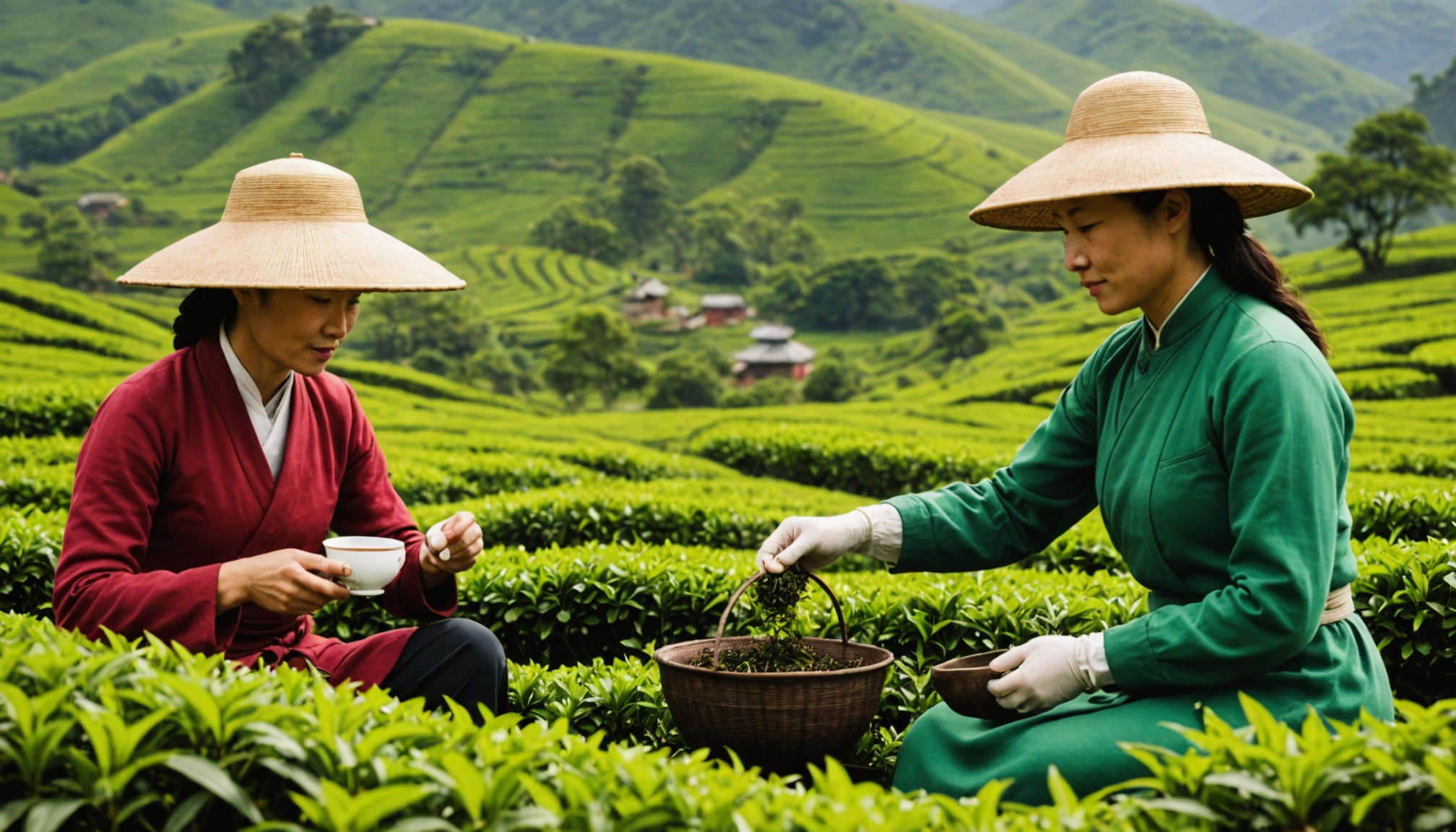
Uncover the Fascinating World of Tea Production and its Secrets
Embark on a Journey into the World of Tea Production

Embark on a journey to uncover the fascinating world of tea production and delve into its well-guarded secrets. From the lush plantations to the meticulous harvesting techniques, the realm of tea cultivation is a captivating blend of artistry and science. Join us as we explore the enchanting process of transforming delicate tea leaves into the aromatic brews that have captivated cultures for centuries. Discover the intricate rituals and age-old traditions that shape the flavour profiles of different tea varieties, each with its own unique story to tell. Prepare to be immersed in the rich heritage and the innovative technologies that have revolutionised the tea industry, paving the way for a global appreciation of this ancient elixir.
The Tea Production Process
Plucking and Harvesting of Tea Leaves
The tea production process is a fascinating journey that begins with the careful plucking and harvesting of tea leaves. Skilled workers meticulously select the top two leaves and a bud from the tea plant, as these portions contain the highest concentration of flavour compounds. However other plucks with just the bud, one leaf and the bud or more leaves than two also exist. The timing of the harvest can significantly impact the final taste of the tea, with some teas requiring delicate early spring leaves while others benefit from heartier late-season foliage.
Withering and Oxidation: Preserving Nature's Essence
Following the plucking stage, the tea leaves embark on a transformative withering and oxidation process. During withering, the leaves are gently spread out to dry, allowing excess moisture to evaporate and rendering the leaves supple for the subsequent rolling stage. This phase is crucial as it sets the foundation for the tea's final flavour profile. Oxidation, a vital step in tea production, is carefully controlled to achieve the desired type of tea. While black teas undergo full oxidation to develop rich, robust flavours, green teas undergo minimal oxidation, retaining a fresh and vibrant taste.
Firing and Drying Techniques: Crafting Flavour and Aroma
The journey of tea culminates in the precise firing and drying techniques employed to enhance the tea's character. Firing, a meticulous process, arrests oxidation and enhances the tea's aroma and taste. The choice of firing method, whether through traditional pan-firing or modern drum roasting, greatly influences the tea's final nuances. Subsequently, the dried leaves are meticulously processed to prevent moisture reabsorption and preserve the tea's quality. Various drying methods, such as air-drying or oven-drying, are utilised based on the tea type, ensuring optimal preservation of flavour and aroma.
Expanding Horizons and Innovations
Beyond tradition, the world of tea production continues to evolve with innovative techniques and sustainable practices. From experimenting with unique terroirs to implementing eco-friendly processing methods, tea producers are dedicated to offering exceptional teas while respecting the environment. By embracing experimentation and technological advancements, the tea industry is poised for a future where ancient traditions harmonise with modern sustainability.
Embrace the Art of Tea Production
The art of tea production encapsulates centuries of tradition, expertise, and reverence for nature's bounty. With each cup of tea, savour not just the flavours but the craftsmanship and dedication woven into every leaf. Let each sip be a tribute to the intricate process that transforms humble leaves into a symphony of taste and aroma.
Role of Processing in Tea Taste
Tea quality is an intricate dance of nature, expertise, and tradition. One of the key factors influencing the flavour profile of tea is the concept of terroir. Terroir refers to the environmental factors, including soil, climate, and altitude, that contribute to the unique characteristics of tea grown in a specific region. By understanding the impact of terroir, tea enthusiasts can appreciate the subtle nuances in flavour that distinguish teas from different origins.
Another crucial aspect of tea quality is the art of blending. Skilled tea blenders can create complex and balanced flavour profiles by combining different tea varieties. Through the careful selection and mixing of leaves, blenders can enhance the aroma, taste, and appearance of the final blend, resulting in a harmonious cup of tea that delights the senses.
Additionally, the role of processing techniques cannot be overlooked when it comes to tea quality. The way tea leaves are processed, including methods such as withering, rolling, oxidation, and firing, greatly influences the final taste and aroma of the brewed tea. Each step in the processing journey affects the chemical composition of the leaves, resulting in a diverse range of tea styles, from delicate white teas to robust black teas.
The secrets behind tea quality lie in the intricate relationship between terroir, blending, and processing. By delving into these aspects, tea lovers can deepen their appreciation for the art and science of tea production, ultimately enhancing their tea-drinking experience.
Exploring Tea Regions and Their Terroir
The Influence of Climate, Soil, and Altitude on Tea Characteristics
When it comes to understanding tea quality, the concept of terroir plays a significant role. Terroir encapsulates a range of environmental factors that influence the growth and flavour profile of tea. Climate, soil composition, altitude, and even the surrounding vegetation all contribute to the unique terroir of a tea-growing region. For example, high-altitude tea gardens may produce teas with a more delicate flavour due to slower leaf growth, while teas grown in volcanic soil might exhibit mineral notes in their taste.
Furthermore, the Impact of Terroir on Tea Flavour goes beyond just the physical environment. The traditions and expertise of local tea producers also shape the final product. For instance, the way tea is cultivated, harvested, and processed in Darjeeling, India, differs from the methods used in Yunnan, China, leading to distinct flavour profiles that reflect the terroir of each region.
Mastering the Art of Tea Blending
The Symphony of Flavours in a Tea Blend
Tea blending is a fine art that requires a deep understanding of different tea varieties and a keen palate. Skilled blenders meticulously select teas with complementary characteristics to create blends that are greater than the sum of their parts. By combining teas with varying levels of oxidation, from lightly oxidised green teas to fully oxidised black teas, blenders can craft a blend that offers layers of flavour and complexity.
Moreover, the art of blending allows for the creation of signature blends that carry the essence of a particular tea house or region. Blenders may add floral notes from jasmine-scented teas or smoky undertones from Lapsang Souchong to develop a unique flavour profile that sets their blend apart.
Unveiling the Journey of Processing Techniques
From Leaf to Cup: The Transformation of Tea
The processing of tea leaves is a critical stage that determines the final taste, aroma, and appearance of the brewed tea. Each processing step, from withering to firing, impacts the chemical composition of the leaves and influences the style of tea produced. For example, white teas undergo minimal oxidation, resulting in a delicate brew with subtle floral notes, whereas black teas are fully oxidised to develop rich, malty flavours.
Furthermore, the skill and precision of tea masters in executing processing techniques are paramount to achieving consistency and quality in tea production. The timing of each step, the level of oxidation, and the application of heat all contribute to the nuanced flavours and textures found in different tea styles.
In essence, the secrets behind tea quality are unveiled through an exploration of terroir, blending, and processing. By immersing oneself in the world of tea production, one can truly appreciate the craftsmanship and dedication that go into creating a perfect cup of tea.
Sustainability in Tea Production
As the demand for ethically sourced and environmentally friendly products continues to rise, the tea industry is also shifting towards more sustainable practices. Tea Rebellion is at heart of this transition and blogs on the topic of Regenerative Tea Farming: Think Soil Carbon Water and Biodiversity and the Tea Farm of the Future.
Future Trends in Tea Production
As the world of tea continues to evolve, several trends are shaping the future of tea production. From technological advancements in tea processing to the rise of biodynamic farming practices and the changing landscape of consumer preferences, the tea industry is undergoing a significant transformation. In this blog section, we will explore these key trends and their impact on the future of tea production.
Tech Innovations in Tea Processing
In recent years, technological innovations have revolutionised the way tea is processed. From automated harvesting machines to advanced drying and curing techniques, technology is playing a crucial role in improving the efficiency and quality of tea production. For example, the use of precision machinery in withering and rolling processes has led to increased consistency in tea leaves, resulting in better flavour profiles and overall product quality.
Consumer Preferences in Tea Varieties
With an increasing focus on health and wellness, consumers are becoming more discerning in their tea choices. From traditional black and green teas to herbal blends and exotic varieties, the demand for diverse tea options is on the rise. Consumers are also showing a growing interest in teas with specific health benefits, such as immunity-boosting properties or stress-relieving effects. As a result, tea producers are expanding their product offerings to cater to these changing preferences and market demands.
The future of tea production is being shaped by a combination of technological advancements, sustainable farming practices, and evolving consumer preferences. By staying abreast of these trends and adapting to the changing landscape of the tea industry, producers can position themselves for success in the dynamic world of tea production.
Conclusion
Delving into the intricate world of tea production has allowed us to gain a deeper appreciation for the complexities and secrets that lie behind our favourite brew. From the meticulous cultivation of tea leaves to the careful processing techniques, the journey from plant to cup is a fascinating one that showcases the skill and dedication of those involved in the industry. By understanding the nuances of tea production, we not only enhance our enjoyment of a simple cup of tea but also develop a greater respect for the heritage and craftsmanship that goes into every sip. Cheers to the magical world of tea production and the hidden secrets waiting to be discovered!.
